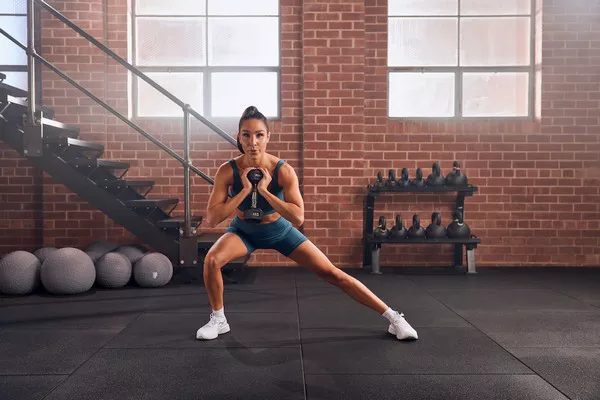Strength training, also known as resistance training or weightlifting, is a vital component of a well-rounded fitness regimen. It involves the use of resistance to build and develop muscle strength, power, and endurance. Incorporating strength training exercises into your routine can yield numerous health benefits, enhance physical performance, and promote overall well-being. In this article, we will explore various types of strength training exercises, considerations for designing an effective strength training program, and offer four examples respectively focusing on core muscles, weight loss, leg muscles and upper body strength.
SEE ALSO: 6 Surprising Long-Term Benefits of Regular Strength Training, According to Studies
Types of Strength Training Exercises
Strength training exercises can be categorized into different types based on the movement patterns and muscle groups targeted. Here are some common types of strength training exercises:
1. Compound Exercises
Compound exercises engage multiple muscle groups and joints simultaneously, making them highly efficient for building overall strength and muscle mass. Examples include squats, deadlifts, bench presses, and overhead presses. These exercises mimic natural movement patterns and promote functional strength.
SEE ALSO: Compound Strength Training: An Approach to Maximize Muscle Gains and Functional Fitness
2. Isolation Exercises
Isolation exercises focus on working a single muscle group. They are useful for targeting specific muscles that might need extra attention. Examples include bicep curls, tricep extensions, and leg extensions.
3. Bodyweight Exercises
Bodyweight exercises use your own body as resistance and are excellent for developing functional strength, flexibility, and coordination. Push-ups, pull-ups, planks, and bodyweight squats are prime examples of bodyweight strength training exercises.
4. Resistance Band Exercises
Resistance bands provide constant tension throughout the movement, engaging muscles effectively. They are versatile and suitable for all fitness levels. Exercises such as banded rows, lateral raises, and leg abductions can be performed using resistance bands.
5. Free Weight Exercises
Free weight exercises involve the use of dumbbells, barbells, and kettlebells. These weights require stabilization, which engages additional muscles for balance. Examples include dumbbell lunges, barbell rows, and kettlebell swings.
Designing an Effective Strength Training Program
To reap the full benefits of strength training exercises, it’s essential to design a well-structured program tailored to your goals and fitness level. Here are some considerations:
1. Set Clear Goals
Identify your goals, whether they involve building muscle, increasing strength, or improving overall fitness. Your goals will determine the exercises, sets, reps, and weights you use.
2. Progressive Overload
Progressive overload is the gradual increase in resistance to challenge your muscles. This can be achieved by increasing weights, reps, or sets over time. It’s a fundamental principle for continuous gains in strength.
3. Frequency and Rest
Allow muscles sufficient time to recover and grow. Beginners might start with 2-3 sessions per week, while more experienced individuals could train specific muscle groups 4-5 times a week.
4. Proper Technique
Using correct form is crucial to prevent injuries and maximize results. Consider working with a certified personal trainer to learn proper technique, especially when starting out.
5. Balanced Routine
Design a balanced routine that targets all major muscle groups. Incorporate both compound and isolation exercises to ensure overall muscle development and prevent imbalances.
6. Warm-up and Cool-down
Always start with a proper warm-up to increase blood flow and prepare your muscles for the workout. Similarly, a cool-down routine can aid in muscle recovery and flexibility.
Example #1 Core-Targeted Strength Training Workout
Here’s an example of a strength training workout that specifically targets the core muscles. This workout can be done 2-3 times a week, with at least a day of rest between sessions. Remember to warm up before starting the workout and cool down afterward. You can adjust the intensity, repetitions, and weights based on your fitness level.
Warm-up:
5-10 minutes of light cardio (e.g., jogging, jumping jacks)
Dynamic stretches for the core and hip muscles (leg swings, torso twists)
Workout:
Perform each exercise for the recommended sets and repetitions, with a 30-60 second rest between sets.
1. Plank – 3 sets of 30-60 seconds
Start with a basic plank position on your forearms and toes.
Engage your core muscles and keep your body in a straight line from head to heels.
Hold the position for the designated time, focusing on maintaining proper form.
2. Bicycle Crunches – 3 sets of 15 reps (each side)
Lie on your back, hands behind your head, and knees lifted.
Alternate bringing your right elbow towards your left knee while extending your right leg.
Repeat on the other side in a pedaling motion.
3. Hanging Leg Raises – 3 sets of 10-12 reps
Hang from a pull-up bar with your arms fully extended.
Keeping your legs straight, lift them up towards your chest by engaging your lower abs.
Lower your legs back down under control.
4. Russian Twists – 3 sets of 20 reps (10 each side)
Sit on the floor with your knees bent, feet lifted, and lean back slightly.
Hold a weight or medicine ball with both hands and twist your torso to each side.
5. Dead Bug – 3 sets of 12 reps (each side)
Lie on your back with your arms extended towards the ceiling and knees bent.
Lower your right arm and left leg towards the ground while maintaining a stable core.
Alternate sides.
6. Side Planks – 3 sets of 20-30 seconds (each side)
Lie on your side, propping yourself up on your forearm.
Lift your hips off the ground, creating a straight line from head to heels.
Engage your obliques to maintain the side plank position.
7. Medicine Ball Slams – 3 sets of 12 reps
Hold a medicine ball above your head with both hands.
Explosively slam the ball onto the ground in front of you, engaging your core.
Catch the ball on the rebound and repeat.
Cool-down:
5-10 minutes of light stretching, focusing on the core and hip muscles (e.g., cat-cow, seated spinal twists)
SEE ALSO: Core Strength Training: Benefits & Guidance
Example #2 Full-Body Strength Training Workout for Weight Loss
Here’s an example of a strength training workout that targets weight loss by combining compound exercises to increase calorie burn and build lean muscle mass. This workout focuses on full-body engagement and can be performed 3-4 times a week, with at least a day of rest between sessions. Make sure to warm up before starting and cool down after completing the workout.
Warm-up:
5-10 minutes of light cardio (e.g., brisk walking, jogging)
Dynamic stretches for major muscle groups (arm circles, leg swings)
Workout:
Perform each exercise in circuit format with minimal rest between exercises. Rest for 1-2 minutes at the end of each circuit before repeating. Aim for 2-3 circuits.
Circuit 1
Perform each exercise for the recommended sets and repetitions before moving to the next exercise.
1. Squats – 3 sets of 12-15 reps
Stand with your feet hip-width apart and toes slightly turned out.
Lower your hips down and back as if sitting in a chair, keeping your chest up and knees tracking over your toes.
Push through your heels to return to the starting position.
2. Push-ups – 3 sets of 8-12 reps
Start in a high plank position with your hands slightly wider than shoulder-width apart.
Lower your body towards the ground by bending your elbows, keeping your core engaged.
Push back up to the starting position.
3. Bent-Over Rows – 3 sets of 10-12 reps
Hold a dumbbell in each hand, hinge at your hips, and bend your knees slightly.
Keep your back straight and chest up as you row the dumbbells towards your hips.
Lower the dumbbells back down with control.
Circuit 2
Perform each exercise for the recommended sets and repetitions before moving to the next exercise.
4. Lunges – 3 sets of 10 reps (each leg)
Step forward with one leg and lower your hips until both knees are bent at a 90-degree angle.
Push through your front heel to return to the starting position.
Alternate legs with each repetition.
5. Dumbbell Shoulder Press – 3 sets of 10-12 reps
Hold a dumbbell in each hand at shoulder height, palms facing forward.
Press the dumbbells overhead until your arms are fully extended.
Lower the dumbbells back to shoulder height.
6. Plank – 3 sets of 30-45 seconds
Start in a push-up position on your hands or forearms.
Keep your body in a straight line from head to heels, engaging your core muscles.
Hold the plank position for the designated time.
Cool-down:
5-10 minutes of static stretching for major muscle groups (quad stretches, hamstring stretches)
SEE ALSO: Best Strength Training Program for Effective Fat Loss
Example #3 Leg Muscle Building Strength Training Workout
Here’s an example of a strength training workout that targets building leg muscles. This workout focuses on compound exercises that engage multiple leg muscle groups to promote muscle growth and strength. Aim to perform this workout 2-3 times a week, with at least a day of rest between sessions. Warm up before starting the workout and cool down afterward.
Warm-up:
5-10 minutes of light cardio (e.g., brisk walking, cycling)
Dynamic leg stretches (leg swings, hip circles)
Workout:
Perform each exercise for the recommended sets and repetitions, with a 1-2 minute rest between sets.
1. Barbell Squats – 4 sets of 8-10 reps
Position the barbell on your upper back and shoulders, gripping it slightly wider than shoulder-width.
Stand with your feet hip-width apart and toes slightly turned out.
Lower your hips down and back into a squat, keeping your chest up and knees tracking over your toes.
Push through your heels to return to the starting position.
2. Romanian Deadlifts – 4 sets of 10 reps
Hold a barbell or dumbbells in front of your thighs with an overhand grip.
Hinge at your hips and lower the weights while keeping your back straight and knees slightly bent.
Lower the weights until you feel a stretch in your hamstrings, then return to the starting position by contracting your hamstrings and glutes.
3. Bulgarian Split Squats – 3 sets of 12 reps (each leg)
Stand a few feet in front of a bench or elevated surface.
Extend one leg behind you and place the top of your foot on the bench.
Lower your hips into a lunge position, ensuring your front knee doesn’t go past your toes.
Push through your front heel to return to the starting position.
4. Leg Press – 4 sets of 10-12 reps
Sit on a leg press machine with your feet shoulder-width apart on the platform.
Push the platform away by extending your knees, then lower it back down under control.
Keep your back against the seat and focus on using your leg muscles to move the weight.
5. Standing Calf Raises – 3 sets of 15-20 reps
Stand on a raised surface (calf raise machine, step, or block) with your heels hanging off the edge.
Raise your heels as high as possible by extending your ankles, then lower them below the level of the platform to stretch your calves.
Cool-down:
5-10 minutes of static stretching for the leg muscles (quads, hamstrings, calves)
Example #4 Upper Body Strength Building Workout
Here’s an example of a strength training workout that targets building upper body strength. This workout includes a variety of compound and isolation exercises to effectively engage the major muscle groups of the upper body. Aim to perform this workout 2-3 times a week, with at least a day of rest between sessions. As always, warm up before starting the workout and cool down afterward.
Warm-up:
5-10 minutes of light cardio (e.g., brisk walking, jumping jacks)
Dynamic arm and shoulder stretches (arm circles, shoulder rolls)
Workout:
Perform each exercise for the recommended sets and repetitions, with a 1-2 minute rest between sets.
1. Bench Press – 4 sets of 8-10 reps
Lie on a flat bench with your feet flat on the floor and grip the barbell slightly wider than shoulder-width.
Lower the barbell to your chest while keeping your elbows at a 45-degree angle.
Press the barbell back up to the starting position, engaging your chest, shoulders, and triceps.
2. Pull-Ups or Assisted Pull-Ups – 4 sets of 6-8 reps
Use a pull-up bar and grip it slightly wider than shoulder-width.
Hang with your arms fully extended and pull your body up until your chin is above the bar.
Lower yourself back down under control.
3. Bent-Over Rows – 3 sets of 10 reps
Hold a dumbbell in each hand, hinge at your hips, and bend your knees slightly.
Keep your back straight and chest up as you row the dumbbells towards your hips.
Lower the dumbbells back down with control.
4. Shoulder Press – 4 sets of 8-10 reps
Sit on a bench with back support or stand with a barbell or dumbbells at shoulder height.
Press the weight overhead by extending your arms, then lower it back down to shoulder height.
5. Tricep Dips – 3 sets of 12 reps
Position your hands shoulder-width apart on parallel bars or the edge of a sturdy surface.
Lower your body by bending your elbows until they are at a 90-degree angle.
Press back up to the starting position using your triceps.
6. Bicep Curls – 3 sets of 12 reps
Hold dumbbells in each hand with your palms facing forward.
Curl the dumbbells towards your shoulders by contracting your biceps.
Lower the dumbbells back down under control.
Cool-down:
5-10 minutes of static stretches for the upper body muscles (chest, back, shoulders, triceps, biceps)
[inline_related_posts title=”For more examples, please check out:” title_align=”left” style=”list” number=”3″ align=”none” ids=”686,801,516″ by=”categories” orderby=”rand” order=”DESC” hide_thumb=”no” thumb_right=”no” views=”no” date=”yes” grid_columns=”1″ post_type=”” tax=””]
Conclusion
Strength training exercises are an integral component of a comprehensive fitness regimen. By incorporating various types of exercises and following a structured program, individuals can experience a wide array of physical and mental benefits. From increased muscle strength and improved metabolism to enhanced functional performance and better mental well-being, the advantages of strength training are vast. When designing your strength training program, remember to set clear goals, focus on progressive overload, prioritize proper technique, and allow adequate rest for optimal results. As with any fitness program, consulting a healthcare professional before starting a new strength training routine is advisable, especially for individuals with pre-existing health conditions. Embrace the power of strength training and pave the way for a healthier, stronger future.
[inline_related_posts title=”Related Topics” title_align=”left” style=”list” number=”3″ align=”none” ids=”1478,1475,1448″ by=”categories” orderby=”rand” order=”DESC” hide_thumb=”no” thumb_right=”no” views=”no” date=”yes” grid_columns=”1″ post_type=”” tax=””]

































